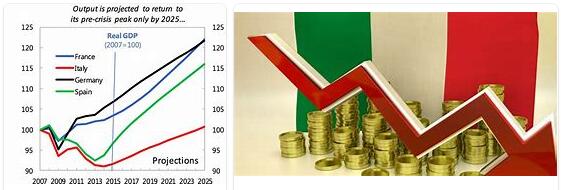In tab. 14 shows, for each of the three sub-periods, the average annual variations of the aggregates referred to in tab. 13, as well as their overall variation from 1960 to 1976.
As you can see by first looking at the last column, the gross domestic product at current prices in the years 1960-1976 has more than sixfold, but most of the increase is of a monetary nature, that is, due to the rise in prices. In real terms, the aggregate itself has increased as from 100 to 218: in other words, the quantity of goods and services available to the community in the seventeen years considered has more than doubled. It should be noted that in the period 1970-76 the average annual increase at constant prices was considerably lower than that recorded in the previous ten years; on the contrary, prices increased most strongly in the 1970-76 period.
The next two aggregates concern the distribution of income: over the entire period 1960-76, compensation of employees at current prices increased from 100 to 986; the other income (from capital, business, self-employment, etc.) instead increased as from 100 to 459. If we take into account the simultaneous increase in prices, and both categories of income are deflated with the price index to consumption, it is noted that, again in the period 1960-76, compensation of employees increased by 228% while other incomes increased by only 51%. It should be noted that in the last period the other incomes have decreased, in real terms, by 0.8% per year. The sharp increase in compensation of employees is one of the significant aspects of the evolution of Italian economy in the last decades; it will be discussed even further on, also in relation to productivity.
Consumption and investments constitute the two internal uses of the final product (the third is made up of exports). From tab. 14 it is noted that, again in the period 1960-76, consumption at 1970 prices increased more than investments; but both have slowed sharply over the past seven years. For investments, in particular, the average annual development rate is zero compared to 8% and 5.4% in the previous two five-year years.
In the tab. 14 also shows the variations relating to imports and exports, which refer to both goods and services (freight rates, insurance, etc.). A comparison between the data of imports and those of exports at current prices over the entire period 1960-76 shows that the increase in imports (+ 1613%) is greater than that of exports (+ 1448%); this is mainly due to the dizzying increase in the prices of imports (essentially those of oil and other essential raw materials for the Italian economy). In fact, at 1970 prices, Italian exports “held up” very well over the entire period, registering an increase higher than that of imports (+ 487% against + 441%).
The dynamics of wholesale and consumer prices are characterized by a rather modest increase in both price categories in the first two five-year years and by a particularly strong increase, especially for wholesale prices, in the most recent seven years. From 1973 onwards in particular, there have been unprecedented increases in the post-war experience: compared to the 1972 average, in 1973 wholesale prices increased by 17.8% and consumer prices by 10.8%; in 1974, compared with the previous year, respectively, by 40.7% and 19.1%; in 1975 there was a slowdown, stronger for wholesale prices (+ 8.6%) than for consumer prices (+ 16.9%); finally, in 1976 there was a new surge in the former (+ 22.9%), while the latter continued to grow at the rate of the previous year (+ 16.8%).
